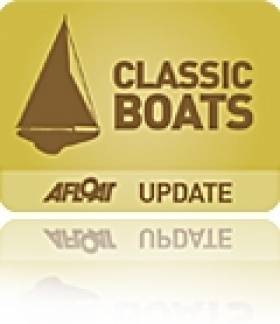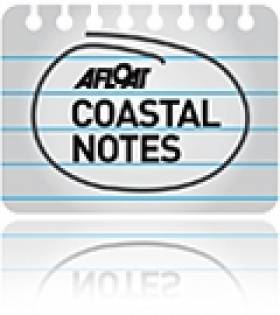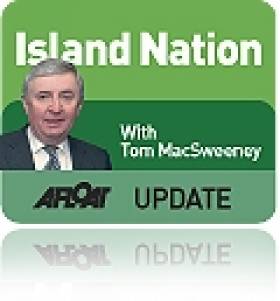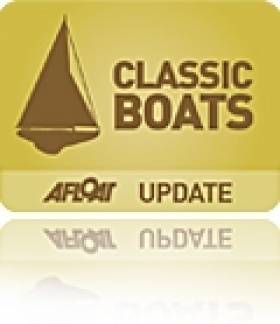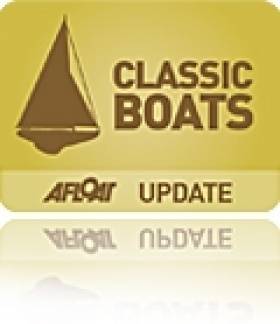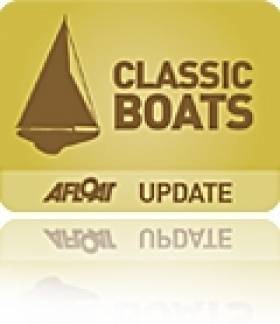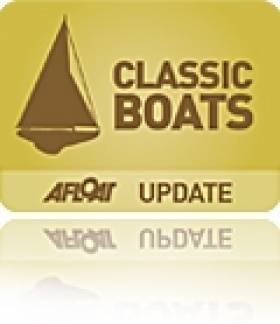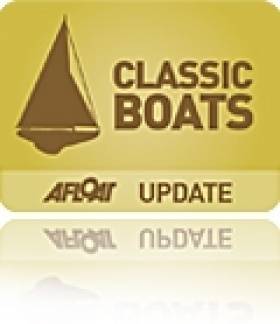Displaying items by tag: Naomh Eanna
Naomh Éanna Refurbishment Partners Sought to Operate Former Aran Ferry
#NaomhÉanna - A campaign continues to transform a former Aran Islands ferry which plied the route from Galway, into a major tourist attraction, reports the Galway Advertiser.
However if a financial plan is not established within a number of weeks there is a risk that the Naomh Eanna will have to be consigned to the scrapyard and Galway will lose out on an attraction which could, in time, be worth millions to the local economy.
The Naomh Eanna was withdrawn from service in 1989 and has been lying derelict in Dublin Port for more than 25 years. Last year it emerged that there were controversial plans by Waterways Ireland for her to be scrapped.
She has now been acquired by the Irish Ship and Barge Fabrication Company as also previously reported on Afloat.ie back in September. The firm specialises in the restoration of high quality heritage maritime holdings.
There are ambitious plans in place for a major refit of the Naomh Eanna to include an 80 bedroom boutique hostel, a restaurant and cafe, an island museum and micro brewery.
It is proposed she will be moored at Long Walk and become a focal point for tourism in Galway.
The Irish Ship and Barge Fabrication Company has begun work to try to structure a financial package to deliver the finished product. It is estimated that the project, which has been approved as a tax efficient investment, will cost €2.4 million.
For more on this development surrounding the Dublin-built veteran vessel, click HERE.
Former Aran Island Ferries Meet in Dublin's Grand Canal Dock Basin
#FormerAranFerries - In recent weeks St. Bridget another former Aran Islands ferry entered Dublin's Grand Canal Dock Basin to join Naomh Éanna, the 1956 built ship that served CIE until withdrawn from service in 1988, writes Jehan Ashmore.
The veteran 300 passenger and freight ferry is berthed in a disused dry-dock and was the topic of a TG4 documentary recently broadcast. Moored nearby is the 1977 built St. Bridget with a 120 passenger capacity that is in winter lay-up following a second season operating coastal excursions for Dublin Bay Cruises.
It is ironic the pair should be sharing company together, given plans to restore and refit the riveted 137ft hulled Naomh Éanna as a tourist attraction and return her westbound to her old homeport of Galway. Whereas St. Bridget, formerly named Galway Bay, was repositioned last year for east coast duties for newcomer Dublin Bay Cruises.
St. Bridget's season this year involved an expanded network of excursion routes linking Dublin city-centre, Howth and Dun Laoghaire harbours in addition to running an evening cruise to Killiney Bay.
According to the operator, the most popular excursion service was Dublin City via the Dun Laoghaire to Howth service. As well as these sight-seeing services St. Bridget served clients for private charters.
As the Galway Bay, not to be confused with other ferries of the same name, (notably the restored Calshot in Southampton), her career on the western seaboard included Rossaveal to Kilronan. She then had a spell on the Cleggan-Inishbofin service.
In recent times it is understood she returned to Aran service when running from Co. Clare under her current owner's sister company Doolin2Aran Ferries.
The 26m steel-hulled St Bridget is one of five passenger ships owned and operated by the Garrihy family which run both the companies. She is scheduled to resume regular sailings in April 2015.
Naomh Éanna Aran Islands Ship TV Documentary Airs Tonight On TG4
#naomheanna – Donncha Mac Con Iomaire's maritime programme on the Naomh Éanna ship airs tonight on TG4 at 21:30. Rusted and with little future she was sentenced to be scrapped, until a few men embarked on a plan to bring new life to the Naomh Éanna. The news of the bid to rescue her from Grand Canal Dock was told by Afloat.ie last February and now the tale makes the small screen.
The Naomh Éanna provided all the neccessities the three Aran Islands had with the mainland for 30 years. CIÉ's rivited ship brought everything from summer students and sheep to Galway, and ice cream and coal to the windswept isles. The Naomh Éanna was at the end of a great era of shipbuilding in Dublin but was ill-designed to service three islands in which she could only moor at one pier! The curragh men of Inis Meáin and Inis Oirr battled the wild Atlantic to keep connected to the outside world.
If you missed it the Docu is now on the TG4 player here
Preserving The Naomh Éanna, GPS Failure, & Buying An Island?
#IslandNation - Readers of this blog have been kind in welcoming me back to the airwaves, for which I am grateful. Community radio on which I now broadcast is quite a big operation about which I did not know a lot until I met the people who run Community Radio Youghal, CRY104FM, in the seaside town on the East Coast of County Cork. At their invitation I returned to the airwaves, broadcasting THIS ISLAND NATION every month and with more development now ahead, thanks to the positive response of listeners.
Every week 2,000 radio volunteers around the country engage with 307,000 listeners, broadcasting from 22 fully licensed stations, in addition to which there are a number of stations at different stages of development. Community radio is a rapidly growing broadcasting sector and a force for community development, identity and expression.
A community radio station is not focussed solely on broadcast schedules, which are subject to the diktats of commercial interests for advertising purpose. So it has a stronger focus on the values and interests of the community to which it broadcasts and can provide a wider variety of broadcasting. It appears to me that it can offer what is missing from mainstream media, newspapers, radio and television - and that is a regular forum for maritime news, information, comment and opinion, related directly to communities. The mainstream media, with a few exceptions, does not give sufficient regular, informed, balanced coverage of the marine sphere.
Transmission of THIS ISLAND NATION as a monthly radio programme about the sea, with the well-known signature tune ‘Sailing By', began earlier this year and interest has grown. ‘Sailing By’ was dropped by RTE as the signature tune for the programme Seascapes, which I had developed and broadcast there for over 20 years.
NEAR FM 90.3 community radio for Dublin North East and Raidió Corca Baiscinn 94.8 FM in County Clare also broadcast THIS ISLAND NATION, as does Afloat.ie on this website. I am hopeful that more community stations around the country will join in broadcasting the programme, for which the plan now, in response to growing interest, is to increase transmission from monthly to fortnightly from next month. CRAOL is the national representative body for the community radio movement.
With modern technology it is quite easy to listen to radio stations broadcasting from anywhere around the country. The app Tune In Radio, which can be downloaded from the Google Play store, is great for listening to radio anywhere. Download it and you have access to all radio stations on Adroid smartphones, tablets, laptops and desktops. That includes, of course, those which broadcast THIS ISLAND NATION.
PRESERVING THE NAOMH ÉANNA
After what has been a long battle against what seemed to be the complete disinterest of Government and State agencies in maritime heritage, Sam Field Corbett tells me that his Irish Ship & Barge Fabrication Company has acquired the heritage ship Naomh Éanna – “effectively securing the vessel for the next three months,” he says. “During this period IS&BF will complete the in-depth survey required to calculate the cost of repairing the hull and machinery to compliment the calculations for her refit as a boutique hostel, restaurant, cafe and museum.”
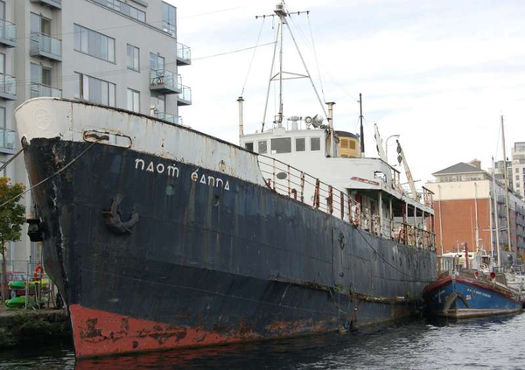
The Naomh Éanna was built by the Liffey Dockyard and launched in the late 1950s. Until 1988, it served as the Galway-Aran Islands ferry and had been operated by CIE. The vessel was purchased by the Irish Nautical Trust and moored at Grand Canal Dock in 1989 after it was decided that it could no longer operate as a passenger-carrying vessel.
Waterways Ireland, owners of the Grand Canal Dock, had determined to scrap the ship, maintaining that its condition was unsafe. WI had little interest in listening to proposals for preserving the ship. There was a debate about it in the Dáil which was told that the underwater archaeological unit of the Department of the Environment did not consider that the Naomh Éanna should be protected and disregarded the fact that it was “an example of the shipbuilding techniques used in the Liffey Docks in the 1950s”. That type of history, according to the Department, did not “justify the expense that would be involved in its preservation”.
Closed minds towards maritime heritage continue to dominate official circles but Sam Corbett refused to give up. Those supporting him had to fight against the attitude of officialdom which sought to exclude several of those who could be considered ‘stakeholders’ from meetings about the future of the ship, according to those who had an open mind the future of the vessel.
Sam Corbett tells me that “the final part of the negotiations” lies with NAMA “who seem close to issuing the three-month lease on the site which will allow surveyors to access the ship and determine her condition.
“Difficulties regarding a €50,000 bond in favour of Waterways Ireland should they be expected to step in and remove (scrap) the ship should IS&BF efforts to secure funding fail, may be close to being resolved. IS&BF presented Nama with an undertaking by a recycling company experienced in specialist breaking and NAMA are considering this option. We hope to have a decision shortly.
"IS&BF are intent on approaching a number of venture capitalists to invest in the project which is presented as a viable business. How the business plan is received by potential investors will ultimately decide the ship’s fate. We have chosen to approach potential investors who have an interest in supporting Irish heritage and jobs.
“This was the original proposition since we became aware the ship was going to be scrapped many months ago. It has been a long process. Without support it would not have been possible. Indeed, it would have surely been scrapped if it had not been for the direct intervention of TDs Kevin Humphreys, Sean Kyne, Joan Collins, Eamonn O Cuiv, Senator David Norris and Councillors Mary Freehill and Dermot Lacey among others.
"Many challenges lie ahead. However, it’s a great accomplishment to have got this far. The money donated by our supporters will be used to conduct the survey as planned and the reimbursement of this money to the RNLI has been included in the project costings. We hope to be able to invite all our supporters to visit the ship when she is being restored and look forward to meeting everyone then.”
Sam Corbett Field is the man who led the restoration of the former Cork Harbour liner tender MV Cill Áirne which could also have been destined for destruction but is now a floating restaurant on the Liffey in the Dublin Docklands near the IFSC. He is also involved in the operation of barges like the Riasc on the Dublin canals. He is not a man who gives up!
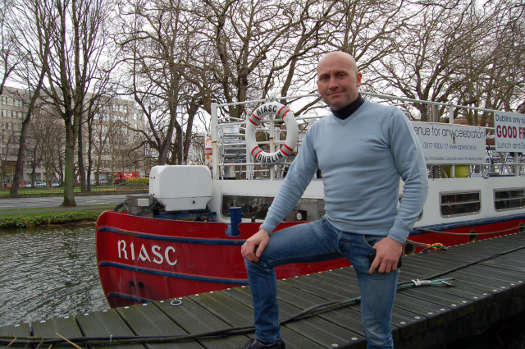
Sam Corbett Field by the Riasc on the Grand Canal
GPS FAILURE
It did not get a lot of public media attention at the time, though it was well-known in maritime circles, when the satellites in the Russian GLONASS GPS system failed for 11 hours last April. It was an unprecedented total disruption of a fully-operational satellite positioning service. As a result, the Russian GPS system was completely unusable to all worldwide GLONASS receivers.
The extent of the disruption has become clear following information released by the General Lighthouse Authorities of the UK and Ireland. GLA readings from their GLONASS receiver in Harwich showed location errors of over 30 nautical miles off the UK coastline.

Apparently the problem occurred because of what were described as “bad ephemerides” being uploaded to satellites. Navigation messages from every satellite requires ephemeris data which is used by the satellite to check its orbital position and information about the time and status of the entire constellation. This data is then processed by user/receivers on the ground to compute their precise position. Less than a fortnight after the first failure, a second malfunction occurred temporarily knocking-out nine GLONASS satellites.
There are, according to information, quite a lot of GLONASS users, including some mobile phone systems. The GLA said that what happened “is a timely reminder that alternatives to satellite navigation are essential”.
The GLA themselves are supporting eLoran as an alternative to GPS for the UK and Ireland. This system transmits long-range position, navigation and timing signals from a ground-based radio network. Its primary use is for ships and others in the maritime sector, but it could provide a back-up for GPS, GLONASS and GALILEO (the long-awaited European system) when it arrives. But eLoran is still proving a hard sell to gain acceptance, according to those in the business.
A Royal Academy of Engineering report in 2011 declared that the UK was becoming dangerously over-reliant on Global Navigation Satellite Systems. Use of space-borne positioning and timing data is now widespread, in everything from freight movement to synchronisation of computer networks. The academy found that “too few of these applications have alternatives should the primary sat-nav signals go down”.
There is a detailed article about the failure of the GLONASS system and the implications for GPS in the September edition of Seaways, the international journal of The Nautical Institute.

BUYING AN ISLAND
There are a lot of interesting things happening along the Shannon, the latest of which is the decision of Clare County Council to buy Holy Island on Lough Derg, which is the largest lake on the River Shannon. The island has links back to Brian Boru. Called also the 'Jewel of the Lough', it is an important historical and ecclesiastical site, covering 50 acres of which four are in the ownership of the Office of Public Works. There are monastic ruins, including a 24m-high round tower, an oratory and church buildings. The island is still used as a burial ground. It is not far from the village of Mountshannon.
DRIFT NETS ABOLITION
The European Fisheries Commission wants to prohibit the use of any kind of drift nets for fishing in all EU waters from January of next year. It would also be made illegal to keep drift nets aboard fishing vessels. It is an all-embracing ban, typical of EU bureaucracy which does not give sufficient consideration before action to the socio-economic effects on, for example, coastal fishing communities, against whom its effects could be discriminatory.
While a ban on the abuse of these nets by big fishing boats from major fishing nations has had some positive effects on salmon stocks and protection of marine mammals, the EU and Irish Governments are ignoring the need, which is clear, for a comprehensive, long-term plan to be devised, with the involvement of local people, for the future of sustainable coastal fishing communities.
As an example of the disregard for coastal communities, the Government has still not responded to the Report of the Oireachtas Committee on Fisheries published last December that called for a Dáil debate and specific attention to be given by Government Departments to the socio-economic problems of Ireland’s coastal and island communities.
WHAT HAPPENS TO A SHIP?
Rarely does the general media report afterwards what happened to a ship aboard which a disaster has occurred. One such vessel was the MV MSC Flaminia, a German-owned container ship which caught fire on 14 July 2012, forcing the crew to abandon ship in the middle of the Atlantic Ocean. Three seafarers were killed.
Due to the damage and the cargo she was carrying, no country would give her ‘safe haven’ after the fire was put out. Eventually, nearly two months later, the German government had to respond to the requests of salvage crews and allowed the damaged vessel to be towed into Wilhelmshaven in Germany on 9 September.

The MV MSC Flaminia on fire in the mid Atlantic
In March 2013 she departed Wilhelmshaven for the Daewoo shipyard at Mangalia in Romania, where repairs were carried out. They were completed this July and the Flaminia, a post-Panamax container ship with a capacity of 6,750 TEUs and deadweight tonnage of 85,823 tons, 980 feet long and 130 feet wide, drawing 48 feet when fully laden, has returned to service. The repair work on the badly-damaged vessel included conversion into a modern eco-ship to reduce fuel consumption.
Email: [email protected]
Twitter: @TomMacSweeney
Progress Underway on Securing Naomh Eanna's Future
#NaomhEanna - Naomh Éanna a former CIE Aran Islands ferry due to be scrapped earlier this year as previously reported, has been acquired by the Irish Ship & Barge Fabrication Company, effectively securing the heritage vessel, writes Jehan Ashmore.
There are plans by IS&BF for a major refit of the veteran vessel that would see her become a tourist attraction back in her former homeport of Galway, as she would feature a boutique hostel, restaurant, cafe and museum in the harbour's single Dun Aengus Dock.
Naomh Eanna is a riveted hulled ship completed in 1958 at the Liffey Dockyard, she carried some 300 passengers and freight including livestock between Galway and the three Aran Islands. She has been lying derelict in Dublin Port for more than 25 years.
She is one of the last such ships built in Europe using rivetted construction technique. In addition she is one of the last ships to be built in the capital and is one of the oldest surviving Irish built ships remaining in our waters.
According to the Naomh Éanna Save Our Ship Campaign, there are negotiations with NAMA over a lease of the graving dock site in Dublin's Grand Canal Basin. This would allow surveyors to access the ship (currently in the graving dock) and determine her hull condition and machinery which is understood to be in working order.
Subject to the outcome of her survey, IS&BF intend to carry out the major refit of the 483 tonnes vessel with her new owners seeking investment from venture capitalists to invest in the project.
Since her shift of berth within Grand Canal Basin earlier this year, there has been an ongoing dispute by campaigners to save Naomh Eanna from scrapping by Waterways Ireland, the Department of Arts, Heritage and the Gaeltacht and NAMA.
Prior to Naomh Éanna's relocation earlier this year, she had been laid-up at her long-term berth alongside Charlotte Quay within the Grand Canal Dock since 1989.
The previous year she had been withdrawn from the west of Ireland service as she failed an inclination test and sailed to Dublin Port. She initially berthed in the capital close to the shipyard from where she was launched into Alexandra Basin.
#NaomhEanna -The Naomh Éanna, a former CIE ferry that campaigners are attempting to save from being scrapped appears to be making progress, reports TheJournal.ie
Having reached a deal to take over responsibility for the vessel with a number of other stakeholders or potential stakeholders involved in deciding her fate.
Only the question of whether NAMA will allow the group to carry out survey and repairs as previously reported on Afloat.ie on the heritage vessel remains a potential stumbling block.
However, a meeting with the agency is being arranged for the coming days, at which the issue will be discussed.
Built in the Liffey Dock in 1956 and once used to carry passengers and supplies between Galway and the Aran Islands, the ferry has been berthed in Dublin's Grand Canal Dock since the late 1980s — where she has since fallen into disrepair.
Waterways Ireland, which manages the docks, had been planning to scrap the vessel; safety concerns were raised in a hull inspection, and the ship could not be moved from the waterway under her own power.
Campaigners had asked for the plan to scrap the vessel to be delayed — but such a move seemed unlikely, until Minister Jimmy Deenihan announced a last-minute stay of execution earlier this year, following questioning in the Seanad from Senator David Norris.
For more on this latest development, visit HERE.
#NaomhÉanna - Minister for Heritage, Jimmy Deenihan and Waterways Ireland have agreed to restrain the scrapping of the nation's oldest surviving merchant ship, Naomh Éanna until next week, while a campaign group arrange a survey as previously reported on Afloat.ie, to determine her true condition.
The Save Our Ship (SOS) Naomh Éanna campaign group had sought a target of €15,000 in funds which were raised through social media so to dry dock the iconic vessel and determine the structural integrity of the hull's condition.
The vessel completed in Liffey Dockyard in 1958, is moored in the number 2 graving dock in Grand Canal Dock, Dublin Port and the group are under pressure to have all arrangements made to pump out the dock.
In addition they are to chock the vessel so surveyors can access the critical shallow bottom ballast tanks where her frames and keel could have deteriorated.
Should the frames and keel be wasted to the extent that they need replacing then the vessel would be deemed un-economic to restore unless supported by the state as is common in most developed countries, according to the campaigners.
Waterways Ireland would then instruct their contractors L&M Keatings to destroy the ship.
The Minister and Waterways Ireland have made it very clear they will not assist or absorb any expense relating to this survey. Disregarding her status as the Nation's oldest surviving merchant vessel, her connection to Dublin's ship building heritage and her 30 year service between Galway to the Aran Islands.
She represents historic and cultural ties of island life during a career that many people fondly recall sailing on her, though the Underwater Archeological Unit have declared that she has 'no heritage value whatsoever'.
The SOS group dispute this finding as the European industrial heritage directive dictates any industrial artifact over 25 years old is deserving of protection.
The group also points out the employment potential of such an attraction in Galway Harbour (where a berth is available to her). Her proposed use as a multi-purpose floating venue after restoration would consist of boutique hostel, restaurant, cafe, micro-brewery and museum expects to employ more than 45 people.
Should the group manage to organise the dry docking and ascertain she is salvageable following survey due on 7 May, they are determined to negotiate the transfer of the vessel to a holding company.
This company will work on arranging private finance to restore and refit the ship in Dublin in line with the business plan presented to Minister Deenihan in April. Following repairs they are optimistic she will be able to sail under her own steam to Galway for completion.
Another historic vessel, Mary Stanford that had shared company with Naomh Eanna in Dublin's Grand Canal Dock, returned last weekend to her 'spiritual home' of Ballycotton. Co. Cork, where she is to be restored to glory.
The Barnett-class lifeboat was was renowned for her daring role in the rescue of the Daunt Rock lightship's crew in 1936. For the last two decades there has been a campaign to save her which eventually led to her been hoisted out of the basin in March.
Initially she taken by road to a warehouse in Midleton and last weekend she finally completed her journey to east Cork as the Irish Examiner reported and that of her next stage of restoration.
Naomh Éanna's Fate In Balance As Survey Draws Near
#NaomhEanna - The fate of heritage vessel Naomh Éanna still hangs in the balance as moves are made towards a structural survey of the former Aran Islands ferry.
As previously reported on Afloat.ie, the historic boat has been earmarked for scrapping - with both Waterways Ireland and the Department of Heritage said to be reluctant to have anything to do with the restoration of the vessel, which has resided at Grand Canal Basin in Dublin Port since 1989.
Despite this, campaigners have pushed ahead with their efforts to save what's believed to be one of the last surviving riveted ships and give her a new lease of life at a berth in Galway Harbour, a vision outlined in their €1.85 million business plan put together in a race against time.
The first step in this process is to survey the vessel in dry dock, at a cost of some €15,000 to the Naomh Éanna Trust's Save Our Ship (SOS) campaign - which has so far raised funds via a public appeal to pay for divers, workers and small plant hire, as well as insurance and waste disposal.
Sam Field Corbett, of Irish Ship & Barge Fabrication and a key figure in the campaign, says he has now received word from Heritage that the department is willing "to facilitate a proper survey" provided the campaign covers "reasonable costs involved" and "any additional expenses" in preparing the vessel in dry dock for Waterways Ireland's disposal plans, should the survey bring bad news.
The next stage is to pump out the water from the vessel before attempting to access the lower tanks and verify if her frames and internal keel structures are salvageable.
If they are, the minister has requested the SOS campaign to determine if planning would be required to repair the ship's hull in the graving dock. If not, the boat will be allowed to fall over in the dock, after asbestos removal, and ultimately destroyed.
"I was greatly disappointed more support was not forthcoming for what we can see as the preservation of our maritime and Dublin city's industrial heritage, not to mention the job creation possibilities," said Field Corbett.
#NaomhEanna - Campaigners for the preservation of the heritage vessel Naomh Éanna have said their meeting with the Heritage Minister this week "could not be described as constructive".
Last Wednesday the Naomh Éanna Trust's Save Our Ship (SOS) campaign and marine restoration firm Irish Ship & Barge Fabrication Co presented their business plan for the restoration of the former Aran Islands ferry, said to be one of the world's last surviving riveted ships.
TheJournal.ie has more details from the €1.85 million business plan, put together in just four weeks, with artist's renderings of what the Naomh Éanna might look like once converted for use as a floating restaurant with a boutique hostel, a museum and event a micro-brewery, upon relocation to a new berth in Galway Port.
The Naomh Éanna is currently in dry dock at Grand Canal Dock, where she has resided for some 25 years, awaiting a final decision on her fate after Heritage Minister Jimmy Deenihan granted a Seanad-prompted reprieve till tomorrow 31 March.
Sam Field Corbett, of Irish Ship & Barge Fabrication and a key figure in the campaign, said the "comprehensive" plan was just the first step in a process that now requires a proper survey of the vessel before outside investors can be sought for a project that could employ 50 people.
But he has since expressed frustration at the State’s position following the meeting on Wednesday 26 March, claiming that “the main thread of feeling on the minister’s side rested on avoiding any unnecessary expenses or responsibilities being incurred by the State.”
Field Corbett said: "I understand there is some doubt in the minister's department as to the heritage value of the Naomh Éanna. As she is not yet a 100-year-old 'wreck' she is afforded no protection from the minister's department."
Moreover, he said those in attendance - including Minister Deenihan, senior officials from his department and a senior member of Waterways Ireland - "all agreed the proposed business was impressive and workable, yet of little concern of theirs."
For now the Naomh Éanna will remain in dry dock at the campaign's own expense, while a public appeal is being prepared to raise funds for the "essential" comprehensive vessel survey.
#NaomhÉanna – Marine restoration specialists Irish Ship & Barge Fabrication Co in co-operation with the Naomh Éanna Trust's Save Our Ship (SOS) campaign group are to present a €1.86m business plan today to Heritage Minister, Jimmy Deenihan.
As previously reported on Afloat.ie, the minister had called for a 'concrete business plan' and today's presentation of the business plan will be using private funds to restore Ireland's oldest surviving merchant vessel, the former Aran Islands passenger, freight and cattle-carrying ferry.
The group need the minister to intervene and halt the scrapping by Waterways Ireland of the Liffey Dockyard ship completed in 1958 as the reprieve date expires next Monday, 31 March.
The plan was prepared in only 4 weeks and proposes a number of commercial activities on board the Naomh Éanna after restoration: a 82-bed boutique hostel, a 46-seat restaurant, an interactive museum and a micro-brewery plus a café seating 60 people.
Galway Port Company have offered a berth for the restored Naomh Éanna in which CIE had operated the 137ft vessel on the three-hour service to the Aran Islands until 1988. She then sailed to Dublin Port and in the following year she was transferred to the Irish Nautical Trust and berthed in Grand Canal Basin.
The plan describes how the vessel could be repaired in a dry dock in Dublin. Engineers are confident the antique machinery in the ship can be returned to service and the ship will return to her home city under her own steam.




























